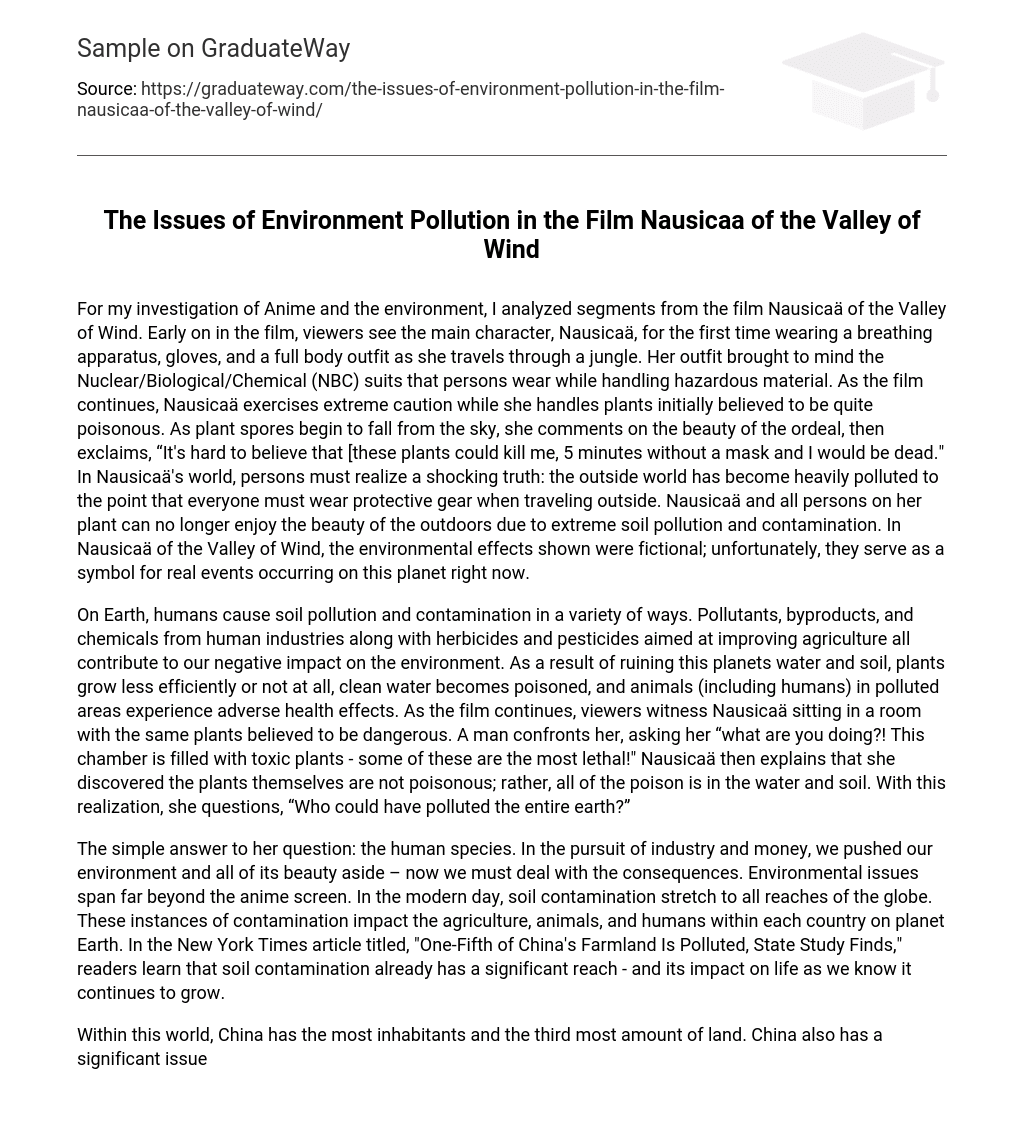For my investigation of Anime and the environment, I analyzed segments from the film Nausicaä of the Valley of Wind. Early on in the film, viewers see the main character, Nausicaä, for the first time wearing a breathing apparatus, gloves, and a full body outfit as she travels through a jungle. Her outfit brought to mind the Nuclear/Biological/Chemical (NBC) suits that persons wear while handling hazardous material. As the film continues, Nausicaä exercises extreme caution while she handles plants initially believed to be quite poisonous. As plant spores begin to fall from the sky, she comments on the beauty of the ordeal, then exclaims, “It’s hard to believe that [these plants could kill me, 5 minutes without a mask and I would be dead.” In Nausicaä’s world, persons must realize a shocking truth: the outside world has become heavily polluted to the point that everyone must wear protective gear when traveling outside. Nausicaä and all persons on her plant can no longer enjoy the beauty of the outdoors due to extreme soil pollution and contamination. In Nausicaä of the Valley of Wind, the environmental effects shown were fictional; unfortunately, they serve as a symbol for real events occurring on this planet right now.
On Earth, humans cause soil pollution and contamination in a variety of ways. Pollutants, byproducts, and chemicals from human industries along with herbicides and pesticides aimed at improving agriculture all contribute to our negative impact on the environment. As a result of ruining this planets water and soil, plants grow less efficiently or not at all, clean water becomes poisoned, and animals (including humans) in polluted areas experience adverse health effects. As the film continues, viewers witness Nausicaä sitting in a room with the same plants believed to be dangerous. A man confronts her, asking her “what are you doing?! This chamber is filled with toxic plants – some of these are the most lethal!” Nausicaä then explains that she discovered the plants themselves are not poisonous; rather, all of the poison is in the water and soil. With this realization, she questions, “Who could have polluted the entire earth?”
The simple answer to her question: the human species. In the pursuit of industry and money, we pushed our environment and all of its beauty aside – now we must deal with the consequences. Environmental issues span far beyond the anime screen. In the modern day, soil contamination stretch to all reaches of the globe. These instances of contamination impact the agriculture, animals, and humans within each country on planet Earth. In the New York Times article titled, “One-Fifth of China’s Farmland Is Polluted, State Study Finds,” readers learn that soil contamination already has a significant reach – and its impact on life as we know it continues to grow.
Within this world, China has the most inhabitants and the third most amount of land. China also has a significant issue with soil contamination. According to a report conducted by the Chinese government as cited in the article above, 19.4 percent (or roughly 1/5) of China’s farmland has become polluted and deemed dangerous for agricultural use. The study shows that almost all of this pollution originates from inorganic materials such as cadmium, nickel, and arsenic – byproducts of human industrial and agricultural activities. Unusable farmland poses an issue for all countries, but especially China as it is burdened by the need to sustain the world’s largest population of over 1.3 billion people. China must take a step back from industry and a step toward caring for the environment if they wish to preserve life within their country. This article remained primarily objective in its analysis of the environmental reports. It did portray the worries and fears arising from overbearing soil degradation. The sources used within this article have strong credibility. The New York Times took their information directly from the Chinese reports and from The Xinhua News Agency – the official press agency of the People’s Republic of China.
I find these sources credible because they were released by the Chinese government and made accessible to the Chinese people. Xinhua is a ministry-level institution overseen by the Chinese central government. This article did not investigate the health risks associated with the contaminated soil. For future research, I would look into the effects of cadmium, nickel, and arsenic within the soil on plants, animals, and humans. Overall, this article served as an informative, striking, and convincing source suitable for any person wishing to delve deeper into environmental issues including those of soil erosion. On a personal note, the facts presented by this article were enlightening and shocking. I knew that China had an issue with pollution, but I did not know their issue was this severe. I am beginning to wonder how they will continue to feed all of the persons within their country if this trend of soil contamination continues.
Works Cited
- Wong, Edward. “One-Fifth of China’s Farmland is Polluted, State Study Finds.” The New York
- Times. The New York Times, 17 Apr. 2014. Web. 18 Jan. 2016.





